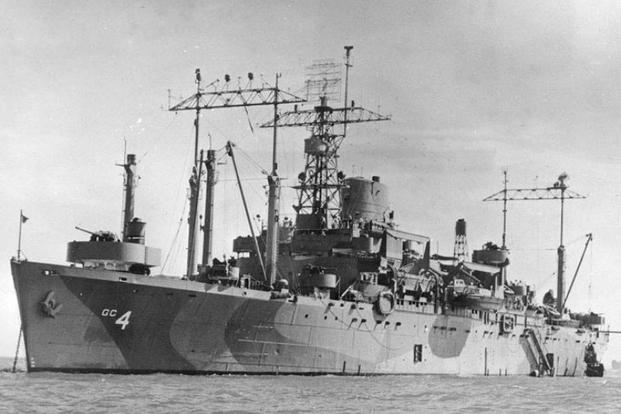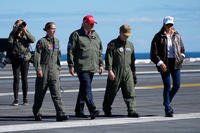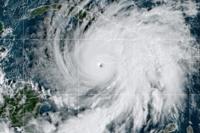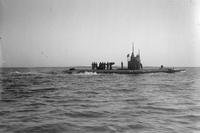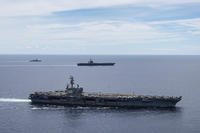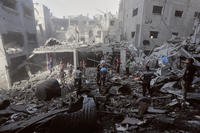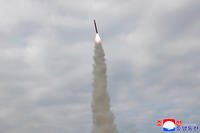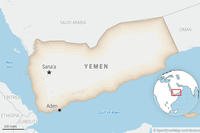In June 1943, in the grade of Colonel, I had gone to England from Alaska and was nominally Engineer of V Corps stationed at Bristol. In early 1944, I was made Deputy Chief of Staff, Plans, V Corps, in charge of the coordination of the plan for the amphibious assault on the continent of Europe. At Headquarters V Corps, we constructed a scale model of the Omaha Beach landing area where each stream, highway, road, trail, orchard, fence and building were shown at proper scale and contour. Models were made of all types of landing craft. Major combat commanders studied these to become familiar with the area which they would land their units and to recognize amphibious equipment they had not yet seen. When I landed on Omaha Beach. I felt I knew the area as though I had been there before.
The plan was so complete that each unit knew the day, the hour and the minute as well as the speed it should travel on the ground to reach the embarkation point on time without causing traffic jams at road intersections. This involved the scheduled movement of nearly one-quarter million men and more than 100,000 vehicles.
The staging area in Britain, 15 miles deep and extending from Portsmouth on the south coast of England west 150 miles to Lands End was cordoned off. For two weeks prior to D-Day, milk and mail trucks were the only civilian traffic in and out of the area. No civilians could leave the area.
Only essential military personnel could leave, and then only with special permission. All telephone conversations were monitored, and mail written in the area was not posted until two-weeks after D-Day. Such were the requirements for mounting a military force of 250,000 men for immediate combat on the other side of the English Channel, a distance of nearly 150 miles to Omaha and Utah beaches.
Rehearsals for the landing were held at Slapton Sands in Cornwall on the west coast of England. All U.S. tactical units scheduled for the assault were to rehearse their operations under assumed combat conditions. In these rehearsals, without exception, the command headquarters afloat lost contact with troops ashore.
I had learned from Lord Louis Mountbatten that in every amphibious operation in which he had a part, there was a failure in communications. I therefore proposed to General Gerow, V Corps Commander, that I be permitted to form an Information Team consisting of 23 officers and men.
We would be equipped with four radio transmitters, two command sets with a range of 400 miles to be mounted in DUKWs (Duplex Drive Amphibious Trucks) and two smaller transmitters to be carried in Jeeps. We were to land immediately behind the assault forces, collect information on the progress of the landing and transmit it directly to the command headquarters afloat. The high command would act only on messages from my radio.
My proposal was approved. My personnel were all volunteers, and I trained them as an extracurricular activity. Our two DUKWs would be loaded on two LSTs (Landing Ship Tanks), and the two jeeps would go over on LCTs (Landing Craft Tanks).
I boarded the LST carrying DUKW #1 on 4 June, and we put to sea almost immediately. At midnight, I learned that we turned back to England because of high wind and rough seas. Shortly after daylight, we dropped anchor and at mid-day again put to sea to follow the schedule previously established. Shortly after midnight, I joined my men on our DUKW in the hold of the ship just inboard of the ramp.
Sixteen other DUKWs were aboard the LST. Each carried a 105mm gun. We didn't know it, but within a few hours 14 of these DUKWs would be at the bottom of the sea, swamped by the high waves or sunk by enemy gunfire. Only two reached the beach.
Our LST was dragging its bow anchor due to wind and sea so rough the crew dared not open the bow door. Later the heavy stern anchor was dropped, the bow anchor was lifted, and we swung about with the bow downwind where the door could be safely opened. Each passing swell brought water almost over the sill of the ramp, then lifted the end of the ramp 14 or 15 feet above the water, only to submerge it when the ramp went down.
We drove onto the ramp arid were signaled to disembark. We cleared the ramp at 0400. I was still dirk. We were nearly 3 hours behind schedule and 12 miles from, shore.
Our radio operators, cooped up in a small boxlike cabin, became desperately seasick, but it affected their operations only when they had to go out to vomit into the sea.
To facilitate secure communications, we had prepared a "one-time" code consisting of the letters of the international phonetic alphabet: "Able, Baker, Charlie," etc. Each letter had a special meaning. Copies were given to all headquarters concerned. Other messages would be encoded by machine.
We went on the air on schedule at 0600 and transmitted "Peter Item King", meaning DUKW #1 afloat. Soon we met empty LCTs returning from the direction of the beach. By their numbers we knew they had carried DD-Tanks (Duplex Drive Amphibious Tanks) suspended on canvas caissons which held the tanks ten to twelve feet below the water surface.
They were driven by two propellers powered by the tank engine. We were surprised that the tanks had been launched in the rough water but reported the passage of the returning LCTs without comment. Later we learned that of 64 DD-Tanks, eight reached the shore and four survived the day.
As we approached the beach, we saw small units of the 1st Division on our extreme left hugging the vertical cliff to escape grenades being dropped on them by the enemy on top the hill. I made several attempts to land, but the three long antennas extending nearly 15 feet into the air above the DUKW drew such intense machine gun and mortar fire that I would withdraw. In any event, we could see little from the beach, whereas we had a complete panorama while at sea. The bullets hitting the sea around us reminded me of hail.
I was in almost continuous radio contact with headquarters on the Ancon in the channel behind us. At 0900, I sent the message: "From 1,000 yards off Dog and Red (the beaches were named from letters of the phonetic alphabet) I see several companies of the 16th Infantry on Easy, Red and Fox Beaches. Enemy fire still effective. LCTs shifting to Dog. About 10 LCTs standing by to land. Obstacles appear thicker than in photos. LCI-85 hit and smoking after unloading. Have seen two LCTs burn. Count ten tanks on Fox. Landing resuming on Dog." This message is in the Situation Report of V Corps for about 0920, 6 June, 1944.
Quickly the situation changed, and the landing stopped, altogether. I radioed General Gerow that the landing had stopped and more than 100 landing craft were milling around like a herd of cattle before a storm and dared not approach the beach due to heavy artillery and mortar fire. In another message I said I believed the Germans were using a church steeple at Vierville as an observation post.
This message was passed by hand from DUKW #2, Lt. Col. Kilburn Houston in charge, to destroyer which immediately fired two salvos at the church steeple, cutting it off at the roof line and blowing if apart. Effective German artillery and mortar fire ceased, shortly thereafter, and the landing resumed.
I landed shortly thereafter, and within fifty feet of where I had gone ashore, met General Millard Wyman, commanding the 1st Division troops. He told me that he had no radio communications; that he had either lost his radio equipment or his operators. I sent a message for him, and as we lay on the ground, mortar shells struck nearby. Six of us were lying close, together. Of these, three were wounded, and three unhurt. My driver, Private James Mildenberger, lying beside me, was hit by a shell fragment which otherwise would have hit me. I was unhurt save for some loss of hearing.
While on the beach, I learned that DUKW #2 had received direct hit and burned, killing one man and wounding two others two Jeeps carrying the small radios had landed in deep water were drowned out. A hue and cry arose from the men on the beach nearby to get the radio out, since it was drawing fire. We turned to the water.
I later learned that the 29th Division too, were without radio communications, so that DUKW #1 was the only radio in operation. This station sent a message every fifteen to twenty minutes for nine hours and later served as the communications center on the beach for several days after the landing.
Within an hour I was able to report a patrol of our troops on the skyline, and shortly thereafter an entire platoon moved up a gully. Enemy small arms fire had slackened. Only a few poorly aimed mortar shells were falling. Units reorganized and advanced according to plan.
The destruction of the church steeple and shelling of German trenches and concrete emplacements by the Navy, plus the actions of a few tanks, and more important, the gallantry of brave men had broken the enemy resistance. Before noon, I sent Message No. 21 to General Gerow: "Troops moving up slope of Fox, Green and Red Beaches. I join you in thanking God for our Navy." My message books are in the Museum of the Invasion at Arromanches, open at this message.
In late afternoon, a German bombardment from heavy long-range guns destroyed nearly two-thirds of our equipment ashore. V Corps asked me if they should continue to send equipment ashore, and I said, "No." That bombardment caused especially heavy losses its the Engineer Group commanded to Colonel John O'Neill charged with destroying the obstacles on the beach. Losses in this group were almost 50% of the entire command. 58% of his officers and nearly 42% of his enlisted men were either killed or wounded on D-Day. Elsewhere, by noon First Lieutenants commanded battalions and Sergeants commanded companies.
In July, 1944, a Special Order of the First Army awarded the Distinguished Service Cross to 33 individuals, including me. The other members of my team each received the Silver Star gallantry in action. This was second only to Jimmy Doolittle's participants in the raid on Tokyo as the largest group of which all were decorated.
